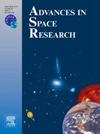The path-tracing simulation of light-field camera system: SurfCam/GrainCams for lunar surface exploration
IF 2.8
3区 地球科学
Q2 ASTRONOMY & ASTROPHYSICS
引用次数: 0
Abstract
The SurfCam is being developed to understand the microscopic lunar surface structures known as the fairy castle structure, composed of grains with an average size of a few tens of microns. It is designed as a microscopic light-field camera (LFC) and is one of the camera instrument packages in GrainCams, a candidate payload for NASA’s Commercial Lunar Payload Services (NASA/CLPS). The light-field camera system allows for obtaining depth maps and 3D images of lunar surface structures on a scale of tens of microns by capturing a 4D light field. This camera system can be achieved by adding a microlens array (MLA) between the main optics and the sensor in a typical camera system. The Cycles render engine, a physically-based path-tracing (one of the ray-tracing types) renderer of Blender 3D software, helps to simulate realistic light-field images. We performed path-tracing simulations by configuring SurfCam’s optics and creating test objects to confirm depth estimation results in Blender 3D. In this study, we present the results of simulated images and analyze them based on the current design of the SurfCam.
求助全文
约1分钟内获得全文
求助全文
来源期刊

Advances in Space Research
地学天文-地球科学综合
CiteScore
5.20
自引率
11.50%
发文量
800
审稿时长
5.8 months
期刊介绍:
The COSPAR publication Advances in Space Research (ASR) is an open journal covering all areas of space research including: space studies of the Earth''s surface, meteorology, climate, the Earth-Moon system, planets and small bodies of the solar system, upper atmospheres, ionospheres and magnetospheres of the Earth and planets including reference atmospheres, space plasmas in the solar system, astrophysics from space, materials sciences in space, fundamental physics in space, space debris, space weather, Earth observations of space phenomena, etc.
NB: Please note that manuscripts related to life sciences as related to space are no more accepted for submission to Advances in Space Research. Such manuscripts should now be submitted to the new COSPAR Journal Life Sciences in Space Research (LSSR).
All submissions are reviewed by two scientists in the field. COSPAR is an interdisciplinary scientific organization concerned with the progress of space research on an international scale. Operating under the rules of ICSU, COSPAR ignores political considerations and considers all questions solely from the scientific viewpoint.
 求助内容:
求助内容: 应助结果提醒方式:
应助结果提醒方式:


